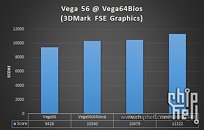Wednesday, August 30th 2017

AMD RX Vega 56 to Vega 64 BIOS Flash - No Unlocked Shaders, Improved Performance
A ChipHell forum user has done what probably others have already done in relative obscurity: trying (and succeeding) to flash a Vega 64 BIOS onto a Vega 56 graphics card. The result? Well, apparently the shaders won't unlock (at least not according to our very own GPU-Z), but interestingly, performance improves all the same. The lesser amount of shaders on the Vega 56 silicon (3585 Shaders / 224 TMUs / 64 ROPs compared to Vega 64's 4096 / 256 / 64 apparently doesn't hinder performance that much. It appears that the improved clockspeeds of Vega 56 after the BIOS flash do more than enough to offset performance loss from the lesser amount of compute resources available, bumping RX Vega's clock speeds of 1471 MHz core boost clock and 800 MHz HBM2 memory up to Vega 64's 1545 MHz core boost clock and 945 MHz HBM2 clock.
This means that Vega 56 can effectively become a Vega 64 in performance (at least where 3D Mark Fire Strike is concerned), which isn't unheard of in the relationship between AMD's top tier and second-best graphics cards. Now naturally, some Vega 56 samples may even be further overclocked than Vega 64's stock clocks, which means that there is the potential for Vega 56 to have even better performance than Vega 64. The BIOS swap should allow Vega 56 to access higher power states than its stock BIOS allows, which is one of the reasons it can unlock higher core and memory clocks than an overclocked, original BIOS Vega 56 would. However, the fact that a Vega 56 at Vega 64 clocks and a Vega 64 deliver around the same score in benchmarks definitely does raise questions on how well the extra computing resources of Vega 64 are being put to use.
Sources:
ChipHell, via Videocardz
This means that Vega 56 can effectively become a Vega 64 in performance (at least where 3D Mark Fire Strike is concerned), which isn't unheard of in the relationship between AMD's top tier and second-best graphics cards. Now naturally, some Vega 56 samples may even be further overclocked than Vega 64's stock clocks, which means that there is the potential for Vega 56 to have even better performance than Vega 64. The BIOS swap should allow Vega 56 to access higher power states than its stock BIOS allows, which is one of the reasons it can unlock higher core and memory clocks than an overclocked, original BIOS Vega 56 would. However, the fact that a Vega 56 at Vega 64 clocks and a Vega 64 deliver around the same score in benchmarks definitely does raise questions on how well the extra computing resources of Vega 64 are being put to use.


60 Comments on AMD RX Vega 56 to Vega 64 BIOS Flash - No Unlocked Shaders, Improved Performance
If you OC Vega 64, I'm sure it will be faster than any OC'd/flashed Vega 56....
There is much room to work on and 3rd party cards will be stellar.
The only "good" thing is that not everyone will try this mod, fearing to brick their cards so vega 64 25% higher price over 56 won't upset people.
A bit of information only useful to us, hardware freaks.
Graphics scale with parallel cores much better then programs scale with CPU cores. I dont see how upping the clock rate and reducing core count would help in something that benefits from parallel processing.
I myself upgrade yearly
As soon as card hits 69c then it drops from 1630 to 1300..